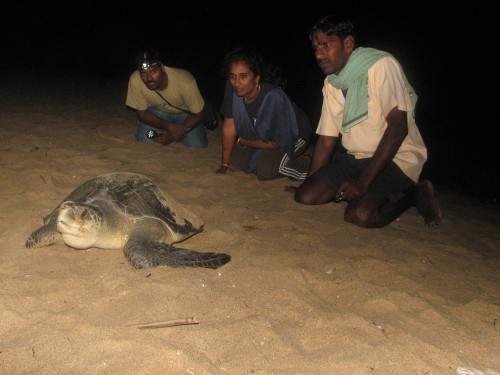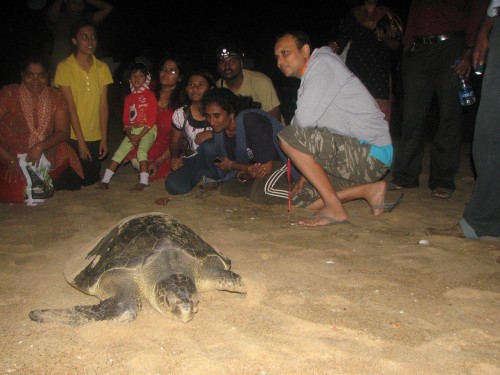Supraja Dharini And Her Turtle Protection Super Squads
Chennai (Women’s Feature Service) Until some years back, he would dig out the leathery, cricket-ball sized turtle eggs from their sand pits and use them to play cricket with his
Chennai (Women’s Feature Service)
Until some years back, he would dig out the leathery, cricket-ball sized turtle eggs from their sand pits and use them to play cricket with his friends. And he was not the only one doing so in the fishing village of Periya Neelangarai on the East Coast Road (ECR), a few kilometres from Chennai, Tamil Nadu. Today, however, young T.A. Pugazharasan is a turtle conservationist.
In fact, during the nesting season of the Olive Ridley turtles, from January extending up to May each year, if you head towards the Coromandel Coast at nightfall, you may find an eclectic bunch of people – school and college kids, lungi-clad fishermen and white collar types – patrolling the beach. Why? Because even though this species of sea turtle is hardy, it faces multiple threats and needs protection.
The Olive Ridley turtle has a remarkable nesting characteristic: It always makes its way back to where it was born to lay its eggs. It reaches the spot – right down to the same 500 metre to one kilometre stretch – and lays the eggs before going back into the sea. The emerging hatchling continues this incredible migratory tradition. Nesting is a regular occurrence on the coasts of Orissa, Andhra Pradesh and Gujarat. But, unfortunately, the turtles and turtle eggs get savaged by people, stray dogs and crows.
Plastic garbage strewn on the beach – that can choke the turtles, lights from the nearby farmhouses and from vehicles plying on the ECR – which confuses them and lures them on to the roads where they get crushed under the wheels of vehicles – or the wiry bushes that entangle them are some of the other threats they face.
That is why the informal protection squads on the beaches as well as the Kadal Aamai Paadukaavalar (Sea Turtle Protection Force or STPF), which comprises over 165 fisher youth living along the Coromandel Coast, are such a boon.
But how is it that turtle conservation has become a priority for the citizens of Chennai and those in its neighbouring towns? For this one can credit artist-conservationist, Dr Supraja Dharini, the woman behind this ‘save the turtles’ mission.

She has not only converted youngsters like Pugazharasan into loving the turtle but has also created a sea change in the attitudes of the local community towards the turtles that inhabit the area. In fact, since 2002, more than 44,654 hatchlings have been safely released into the sea, thanks to Dharini’s initiatives. She has helped remove tonnes of debris from the Chennai coast with the help of the Indian Coast Guard, National Institute of Ocean Technology, South Asia Cooperative Environment Programme and Loyola College. She has campaigned for the protection of sea turtles with thousands of school and college goers in Tamil Nadu – even in towns as far flung as Sivakasi – who now know how crucial it is to provide a safe haven for migrating turtles.
“The world over, there are many people trying to save the turtles, but I find Supraja Dharini’s efforts unique because she manages to bring together all stakeholders, from government ministries to local fisher folk,” says Shannon McDonnell, honorary coordinator for India for Roots and Shoots, an organisation founded by famous primatologist and conservation biologist Dr Jane Goodall. McDonell has been working with Dharini to spread conservation efforts to schools across India.
It’s Dharini’s efforts that have brought together a city youngster like Robin, who is preparing for his IAS exams, and fishermen like T.A. Pugazharasan, to work together for a common cause. “I have been working with ‘madam’ for eight years to save the turtles, and now I see a definite change in our fishing community. A year back, some fishermen used to chop off the flippers of turtles caught in their nets, because they didn’t want to cut their nets. Today, they gently set them free,” informs Pugazharasan.

From being a successful artist – she runs her own art studio, Kalakruti, which she had started in 1991 – to becoming a saviour of turtles, it’s been an interesting transition for Dharini. It was a dead turtle she noticed during a walk on the Neelangarai shore that triggered the change. “I noticed that it had been killed from cuts sustained from sharp wires, perhaps fishing nets,” she recalls. On further inquiry, she found out that many such dead turtles were washed ashore regularly between January and March.
The sight of the dead turtle brought back Jane Goodall’s words she had heard on a television programme: ‘Each and every individual can make a difference’. “I decided that I would make a difference,” Dharini says. Her first move? She went with fishermen on their catamarans and trawlers to gauge what exactly created this pointless massacre. She discovered that fishing nets needed turtle extruders, a device attached to the net that allows turtles to escape from the net, leaving the fish behind. And, more significantly, she understood that awareness building amongst the fishing community was crucial. So she toured village after village, talking about how important turtles are for sustaining fish in the sea, upon which rested the community’s livelihood. She also roped in Dr Karthik Shanker of Wildlife SOS, who showed fisher folk slides portraying how turtles created areas for the fish to breed.
Once the fishing community was won over, it was time to get the youth involved. Youngsters in the villages like Periya Neelankarai, Injambakkam, Pannayur, Nayanarkuppam-Uthandi and Reddykuppam-Kanathur along the ECR were trained to identify places where turtles laid eggs, to gently retrieve them and place them in easily-built safe enclosures, to guard them during their 48-day gestation period, and finally to safely lead the emerging hatchlings to the sea.
Dharini also set up the TREE (Trust for Environment, Education, Conservation and Community development) Foundation in October 2002. She now plans to start a marine biodiversity conservation research centre with a fully-equipped aquarium that would help create more bonding between humans and turtles. “All sea turtles are listed as endangered. The TREE foundation works along the coasts of Chennai and Kancheepuram in Tamil Nadu and Andhra Pradesh with plans to expand the programme nationwide,” says Dharini, who is the founder of the Bay of Bengal Ecologists and Conservation Network (BEACON) as well.
Monetarily, the TREE Foundation functions with the support of its trustees and through donations. Some help comes in from the government: For instance, the Wildlife Wing of the Forest Department (Tamil Nadu) had provided a stipend to members of the STPF during the turtle nesting period since 2006, while the Wildlife Wing of the Forest Department (Andhra Pradesh) has been supporting the STPF from 2009 onwards.
The good work done by Dharini over the years hasn’t gone unnoticed. She was conferred the Whitley Associate Award for 2009-2010, the Disney Worldwide Conservation Award, Sea World and Bush Garden Conservation Award, and the Peoples’ Trust for Endangered Species Award.
Called the Gardeners of the Sea – because they help sea plants grow faster – turtles figure on the protected creatures’ list of India’s Environment and Forests Ministry. And yet, unlike its more famed fellow list-member, the tiger, there are not many who undertake awareness drives for turtle conversation and no celebs rooting for its cause. For now, its survival rests on people like Dharini, her friends and her dedicated protection squads.
(Dr Supraja Dharini and the TREE Foundation can be contacted at: Tel – +91 44 42862014 / 9444052242; Email – [email protected]; Website: www.treefoundationindia.org)
This story made me
- 97
- 121
- 89
- 167











